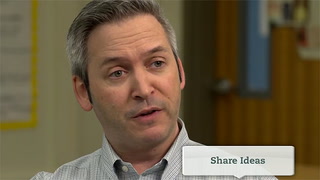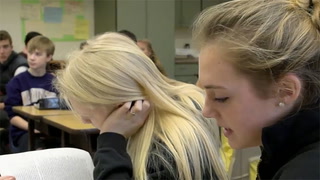Series Evidence & Arguments: Evidence & Arguments: Lesson Reflection
ELA.RI.9-10.2
| Common core State Standards
- ELA: English Language Arts
- RI: Reading Standards for Informational Text 6-\x80\x9312
- 9-10: 9th & 10th Grades
-
2:
Determine a central idea of a text and analyze its development over the course
of the text, including how it emerges and is shaped and refined by specific
details; provide an objective summary of the text.
ELA.W.9-10.6
| Common core State Standards
- ELA: English Language Arts
- W: Writing Standards 6-12
- 9-10: 9th & 10th Grades
-
6:
Use technology, including the Internet, to produce, publish, and update
individual or shared writing products, taking advantage of technology'\x80\x99s
capacity to link to other information and to display information flexibly and
dynamically.
ELA.SL.9-10.1a
Common core State Standards
- ELA: English Language Arts
- SL: Speaking and Listening Standards 6-\x80\x9312
- 9-10: 9th & 10th Grades
-
1a:
Initiate and participate effectively in a range of collaborative discussions
(one-on-one, in groups, and teacher-led) with diverse partners on grades 9-\x80\x9310
topics, texts, and issues, building on others'\x80\x99 ideas and expressing their own
clearly and persuasively.
a. Come to discussions prepared, having read and researched material under
study; explicitly draw on that preparation by referring to evidence from
texts and other research on the topic or issue to stimulate a thoughtful,
well-reasoned exchange of ideas.
b. Work with peers to set rules for collegial discussions and decision-making
(e.g., informal consensus, taking votes on key issues, presentation of
alternate views), clear goals and deadlines, and individual roles as needed.
c. Propel conversations by posing and responding to questions that relate the
current discussion to broader themes or larger ideas; actively incorporate
others into the discussion; and clarify, verify, or challenge ideas and
conclusions.
d. Respond thoughtfully to diverse perspectives, summarize points of
agreement and disagreement, and, when warranted, qualify or justify their
own views and understanding and make new connections in light of the
evidence and reasoning presented.
Save to My Resources
PLEASE CREATE A NEW ACCOUNT OR LOG IN TO ACCESS THIS CONTENT
Enjoy your first video for free. Subscribe for unlimited access.
Have questions about subscribing?
Click Here to learn more about individual subscriptions.
Click Here to learn more about School and Institution access.
Discussion and Supporting Materials
Thought starters
- How does Mr. Hanify ensure students are ready before moving on to the next activity?
- What is meant by "the strategy is not the end"?
- Notice the questions Mr. Balla asks. How could you consider similar questions when reflecting on your practice?
School Details
International School445 128th Avenue Southeast
Bellevue WA 98005
Population: 573
Data Provided By:

Teachers
T.J. Hanify
Newest
|
4 MIN
|
5 MIN
|
5 MIN
UNCUT CLASSROOMS
| TCHERS' VOICE
English Language Arts











18 Comments
Barbara Pope May 18, 2020 3:04pm
Thanks again for this lesson. It is an inspiration, I'm sure, to new and older teachers such as myself. I too could not stop taking notes.
Alfra Jeannele ... Jun 29, 2018 2:21pm
Helene Previl Dec 15, 2016 5:13pm
Patrcia Mesch Jun 17, 2016 10:21pm
Maria Acedo Apr 9, 2016 2:18pm